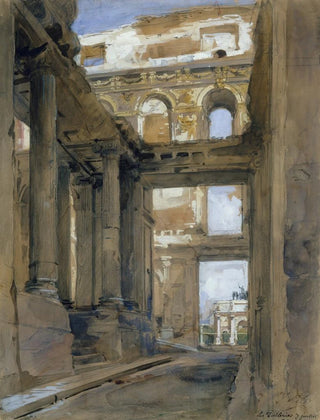Art print | Ruins of the Tuileries Palace - Isidore Pils Source: Reproduction | Ruines du palais des Tuileries - Isidore Pils


View from behind

Frame (optional)
In the world of art, some works transcend their era to become witnesses of history and human emotions. "Ruins of the Tuileries Palace - Isidore Pils" is one of these creations that invites deep reflection on the passage of time and the fragility of human constructions. This painting, which evokes the lost grandeur of an iconic Parisian monument, immerses us in a melancholic atmosphere where beauty and desolation meet. Through this art print, the viewer is invited to explore not only the artwork itself but also the historical context surrounding it.
Style and uniqueness of the work
Isidore Pils's work stands out for its realistic approach and meticulous attention to detail. In "Ruins of the Tuileries Palace," Pils manages to capture not only the architectural elements of the palace but also the atmosphere emanating from the ruins. The play of light and shadow, as well as the nuances of color, bring this scene frozen in time to life. The art print evokes a palpable nostalgia, where debris from a bygone era blends with the surrounding nature, suggesting a disturbed harmony between man and his environment. The composition, both balanced and dynamic, creates a tension between the majesty of the ruins and their state of disrepair, thus inviting the viewer to reflect on the ephemeral beauty of architecture.
The artist and his influence
Isidore Pils, a French painter of the 19th century, is often associated with the academic movement that advocates rigor and technique. His work is marked by a constant pursuit of pictorial truth, as well as a desire to pay homage to history through his representations. Pils established himself as an essential artist of his time, influencing many contemporaries with his ability to combine realism and emotion. His interest in historical themes and genre scenes contributed to enriching the artistic landscape of his era. By choosing to depict the ruins of the Tuileries Palace, Pils aligns with a tradition that values collective memory and reflection on the past, while offering a personal and poetic vision.

Matte finish

View from behind

Frame (optional)
In the world of art, some works transcend their era to become witnesses of history and human emotions. "Ruins of the Tuileries Palace - Isidore Pils" is one of these creations that invites deep reflection on the passage of time and the fragility of human constructions. This painting, which evokes the lost grandeur of an iconic Parisian monument, immerses us in a melancholic atmosphere where beauty and desolation meet. Through this art print, the viewer is invited to explore not only the artwork itself but also the historical context surrounding it.
Style and uniqueness of the work
Isidore Pils's work stands out for its realistic approach and meticulous attention to detail. In "Ruins of the Tuileries Palace," Pils manages to capture not only the architectural elements of the palace but also the atmosphere emanating from the ruins. The play of light and shadow, as well as the nuances of color, bring this scene frozen in time to life. The art print evokes a palpable nostalgia, where debris from a bygone era blends with the surrounding nature, suggesting a disturbed harmony between man and his environment. The composition, both balanced and dynamic, creates a tension between the majesty of the ruins and their state of disrepair, thus inviting the viewer to reflect on the ephemeral beauty of architecture.
The artist and his influence
Isidore Pils, a French painter of the 19th century, is often associated with the academic movement that advocates rigor and technique. His work is marked by a constant pursuit of pictorial truth, as well as a desire to pay homage to history through his representations. Pils established himself as an essential artist of his time, influencing many contemporaries with his ability to combine realism and emotion. His interest in historical themes and genre scenes contributed to enriching the artistic landscape of his era. By choosing to depict the ruins of the Tuileries Palace, Pils aligns with a tradition that values collective memory and reflection on the past, while offering a personal and poetic vision.






